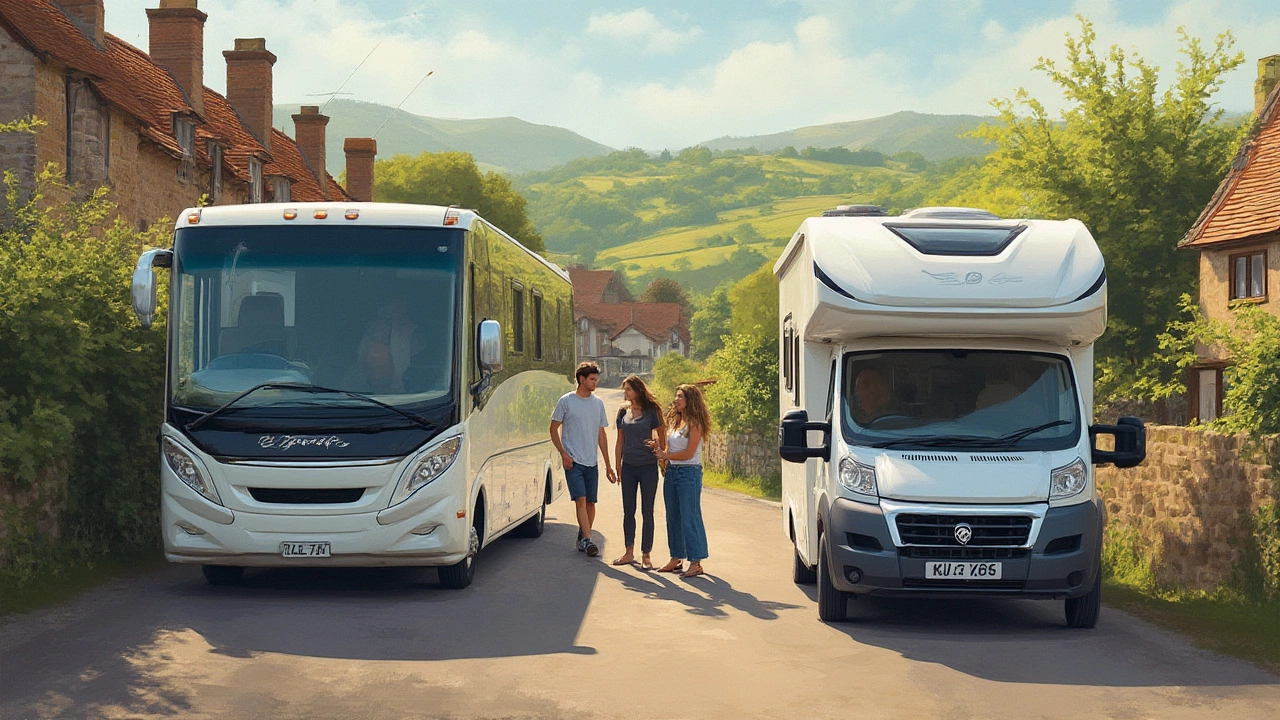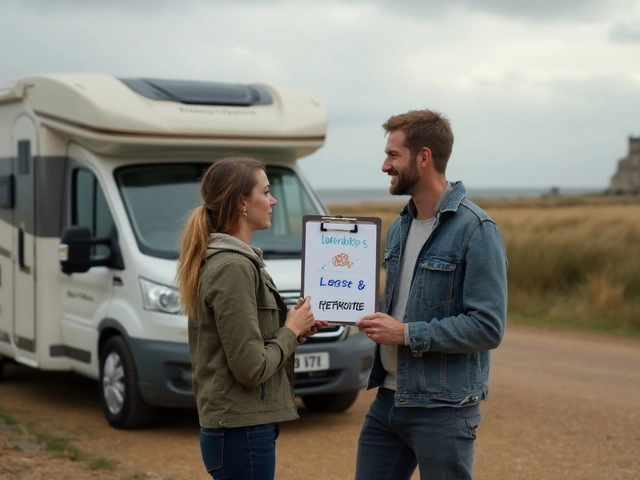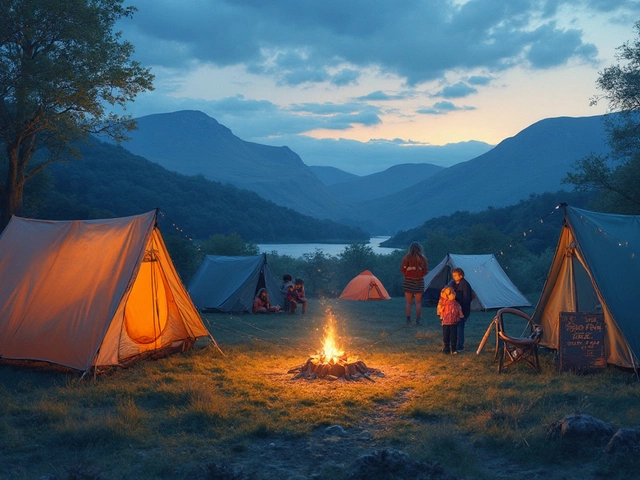Motorhomes are like rolling homes, but when you pull up to a campground, you’ll see a parade of wildly different rigs. Some look like sleek buses, others a bit like overgrown vans. Ever wondered why so many people debate "Class A vs Class C motorhome"? The answer isn’t as obvious as you might think. Behind all those happy family road trip photos, there’s a serious tug-of-war going on between comfort, cost, drivability, and yes—pet friendliness. Rex, my loyal mutt, has made it clear which RV he likes best, but I’ll let you decide yours.
The Big Picture: What Sets Class A and Class C Motorhomes Apart?
Start with looks. Class A motorhomes are those giant, rectangle buses you spot dominating RV parks. They're built on heavy-duty frames, sometimes even old commercial bus or truck chassis. Lengths reach from a "just big" 25 feet all the way up to 45 feet, which is taller than a London double-decker. The driver sits up high, just like in a bus, with one huge windshield—the kind that makes you feel like the king of the open road.
Now, Class C motorhomes are the familiar ones with that over-cab bed area that sort of sticks out over the driver like a baseball cap. These are usually built on a van or pickup chassis and run anywhere from about 20 to 33 feet. Sitting behind the wheel of a Class C feels more like driving an oversize delivery van than a spaceship.
One look at a table comparing the two and you can see why the debate heats up so fast:
| Aspect | Class A Motorhome | Class C Motorhome |
|---|---|---|
| Typical Length | 25–45 ft | 20–33 ft |
| Driving Experience | Bus-like, high seating | Van-like, easier to handle |
| Price Range (New, 2025) | $100k–$500k+ | $70k–$200k |
| Sleeping Capacity | 4–8 | 2–8 (with cab-over bed) |
| Fuel Efficiency | 6–10 mpg | 9–14 mpg |
| Ideal For | Full-time families, luxury seekers | Smaller families, weekend trips |
The chassis tells you a lot: if you want a monster for space and storage, Class A is your game. If you want something that feels more like the car you already drive, Class C is probably less intimidating.
You’ll notice fuel economy isn’t great on either. But that’s not why people camp in motorhomes—the real draw is the freedom to bring your home wherever you park.
Comfort, Layout, and Travel Style
Here’s where the fun begins. Class A rigs are made for stretching out. Think double couches, slide-out walls that magically add square footage, full-sized fridges, and even washers and dryers in some. The ride is usually smoother, quieter, and, frankly, a bit more like a luxury hotel rolling down the interstate.
Class C, on the other hand, puts everything you need in a smaller shell. The over-cab bed is a huge draw for families with kids or anyone who wants to crash fast after a day of hiking. You’ll usually have a kitchenette, a small dinette, and a bathroom. But no one’s confusing the shower with a spa or the fridge with something out of a downtown condo. Still, for a weekend getaway, who cares?
Travel style matters. Class A owners often hit the road for months at a time. You get giant tanks for water and sewage, more solar options, and storage galore (Rex’s muddy boots, anyone?). With Class C, you’re in and out of places more quickly. They’re nimble—less hassle finding parking, squeezing into smaller campgrounds, or ducking under low-clearance bridges (trust me, you don’t want a Class A disaster story from a drive under an 11-foot bridge).
One thing is certain: space changes everything. More storage means you can bring paddleboards, bikes, and half the snack aisle. But the bigger you get, the more you have to think about where you’ll fit—both on the road and at the campsite.
If you love tailgating, hosting campfire parties, or remote working with a view, Class A feels like your own penthouse with a parking spot. If you prefer flex trips, spontaneous detours, and spending more time exploring than lounging, Class C might as well have your name on it.
Pro tip: If you’ve got pets, especially large dogs, Class A’s wider aisles and bigger floors make life easier when someone (looking at you, Rex) wants to flop in the walkway.

Maintenance, Costs, and Hidden Surprises
This is where a lot of newbie RV buyers get their first reality check. Class A motorhomes cost more—no sugar coating it. New ones in 2025 start around $100,000 and can soar past half a million with all the bells and whistles. Used models help, but even a five-year-old Class A can run higher than a brand-new Class C.
Insurance? More for big rigs. Maintenance? Larger and more complicated, which means pricier repairs if something goes wrong. And fuel costs... let’s just say you’ll get cozy with truck stops. The trade-off? You’re getting what RVers call a true house-on-wheels, often with top-notch insulation, larger onboard generators, and fancier features like electric fireplaces. If you want four-season comfort, Class A rigs usually do it best.
Class C wins on cost nearly every time, both up front and as you roll. Smaller means less insurance, lower taxes and registration, fewer catastrophic repair bills, and better (if still not stellar) gas mileage. They’re also less intimidating if you’re new to RV tech—fixing a leaky faucet or diagnosing a fridge problem isn’t so overwhelming when you’re just one step up from a van. Parts can be easier to find, too, since most are built on Ford E-series cutaway or Mercedes Sprinter platforms.
Another surprise: depreciation hits Class A rigs harder. Because they cost more and have more at stake gadget-wise, they tend to drop in value faster than comparable Class Cs. If you’re thinking about reselling or making frequent upgrades, that matters. And don’t forget storage—unless you live somewhere with massive driveways, parking a 35-foot Class A at home can spawn offsite storage fees, sometimes $100 or more a month.
One quirky thing: car rentals. With a Class A, you might need to tow a separate car (known in RV circles as a “toad”) for errands or sightseeing, which adds complexity and cost. Class C rigs are friendlier for just driving into town, parking, and grabbing groceries.
Which Motorhome Suits Your Life?
So, where do you land in the Class A vs Class C showdown? It really comes down to your travel dreams. Want to spend weeks in the desert, bring every toy, and work remote from a leather couch? You’ll love the luxury, the space, and the road presence of a Class A. If the idea of driving something so large gives you cold sweats, try a Class C first—you’ll hug fewer curbs and sweat less in traffic.
Ask yourself how many people (and pets) you’ll bring. Big families need more sleeping spots. Couples might trade the extra overhead bed in Class C for more living space in Class A. If you’re solo, even a small Class C can feel spacious. Remote working? Class A tend to have more generator power, places for a desk, and better separation for work-play zones.
Where you want to go matters, too. National park campgrounds, with their old-school small sites, are way easier to book and navigate with a Class C. State parks in remote spots or that hidden lake with no hookups? Smaller is helpful there, unless you love planning ahead and double-checking site lengths online. On the other hand, if you’re following big, wide highways and mostly staying at resort-style parks, Class A will shine.
Here’s a tip from experience: rent one of each before buying. A weekend in a Class A feels different than a Class C vacation. Try backing up, making tight turns, refilling water tanks, and wrangling the dog through a rainstorm. That’s where you really figure out what you love—and what drives you crazy.
One thing’s sure—no matter which way you go, the right motorhome is the one that gets you exploring. For me and Rex, nothing beats the freedom of pulling up to a new view every day, comfy or cozy, big RV or small. The road doesn’t care what you’re driving—it just cares that you’re out there, doing it.






